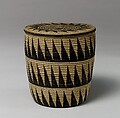Lidded Basket
Not on view
This exquisite lidded basket is the work of a Tutsi weaver from Rwanda. Basket weaving remains one of the most widespread art forms among the ethnic groups of Rwanda and Burundi. The long-standing role of baskets and the basketry tradition in the lives of these peoples has resulted in an art form that serves both a utilitarian function and aesthetic beauty. The surface of this basket features three rows of a repeating triangular-shaped motif in black. The flat cover of the basket is formed from a coiled cylinder. It is decorated with a black dot at the center, out of which radiate concentric circles in alternating colors—black and natural buff. Surrounding the concentric circles is the same repeated triangular motif seen on the side of the basket. The bottom of the basket features a similar starburstlike motif, but consisting of only a central black dot with a number of radiating black triangles. The traditional colors of Tutsi basketry were black, red, and the natural pale gold of the grass; black and red were used for patterns. Black coloring was derived from boiling banana flowers, the black sap of which was used as a dye. The red dye was similarly derived from boiling the root and seeds of the urukamgi plant. By the 1930s, however, imported dyes expanded the palette to include colors like green, orange, and mauve.
This basket, though miniature in scale, displays a remarkable degree of precision and a painstakingly fine weave. Coil-sewn baskets such as these are known as agaseki and were traditionally made by Tutsi aristocratic women. When the Tutsi were the ruling group in Rwanda, the privileged position of Tutsi women allowed them the leisure time necessary to perfect their skill at weaving these ultra-fine and intricately patterned containers, few of which exceeded five or six inches in height. The minority Tutsi people, who number 10–15 percent of Rwanda's population, lost their privileged status after a revolution by the majority Hutu people. As a result, the rich basketry tradition is slowly dying out and increasingly being replaced by plastics. Now, only older women carry on the practice of weaving baskets in the traditional manner. Workshops have also emerged throughout Rwanda that produce baskets and other crafts on a much larger scale. Earlier baskets, such as this example from the Museum's collection, exhibit a quality and intricacy not found in many of the more contemporary examples.
Due to rights restrictions, this image cannot be enlarged, viewed at full screen, or downloaded.
This artwork is meant to be viewed from right to left. Scroll left to view more.



